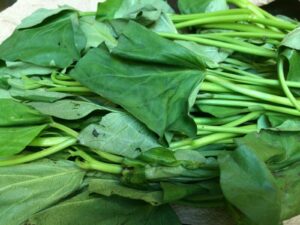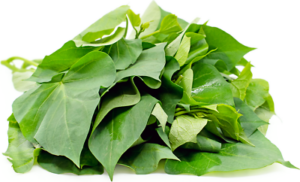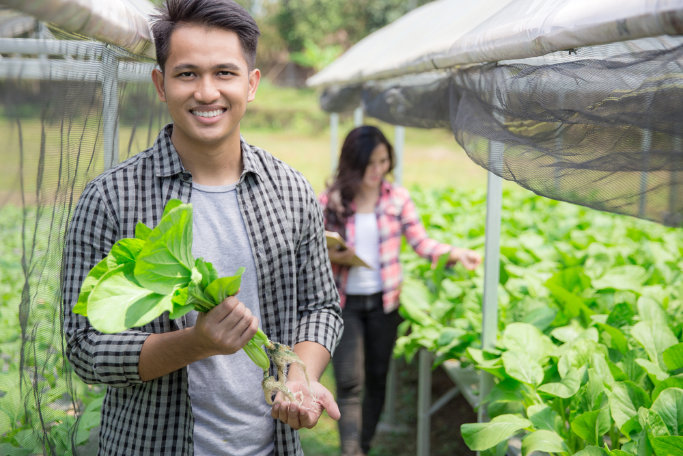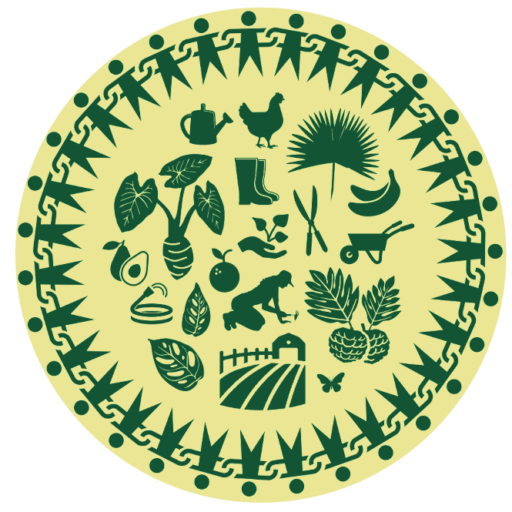Crystal, Jeron and I were at the Council for Native Hawaiian Advancement (CNHA) garden in Kapolei on a Saturday morning. At around 7:00 AM, we harvested what we call “kamote” in Filipino or sweet potato leaves. These sweet potato leaves were planted in June of this year, and it was time for us to fully harvest this leavy, green vegetable and distribute it to the community.

Jeron shoveled the sides of the plot to loosen the soil, then started to dig. With sweet potatoes, one must use their hands. Jeron shoveled the sides of the plot to loosen the soil, then started to dig. Tools can help to break the sweet potatoes from the soil. But Jeron would knock out the soil from roots with his hands until he got to a little bundle of sweet potatoes.

We created about 20 bundles of sweet potato of various sizes. I was a little disappointed that we didn’t produce more.
After we pulled out the potatoes, we were able to pile the bundle of the potato leaves as high as five feet (as tall as me). In the Philippines, the potato leaves can also be cooked and can provide a nutritional food source to people back home.
So the big harvest was not just the potatoes, but the sweet potato leaves. In Tagalog, it means “talbos ng kamote” (young shoots of the sweet potato). I learned how to cultivate this in the Philippines. With the sweet potato, we take the stems, and stick them into the ground. Then wait for the vines to crawl throughout the ground and harvest the greens in about 3 months when they are fully grown.
I grew up eating this as a salad: boiled and wilted then seasoned with salt, vinegar, chopped onions and tomatoes. Refrigerated. Perfect as a side dish to fried fish and rice. Full of fiber!
Is this something that the people of Hawaii should eat more of?
Absolutely. This is the nutritional value of sweet potato leaves.
Macronutrients
Carbohydrates, protein, and fiber
Low in saturated fat and cholesterol
Omega-3 fatty acids, which contribute to all tissues in the body functioning normally, including the heart, lungs, blood vessels, immune system, and hormone production.
Micronutrients (vitamins and minerals)
Vitamins: A, C, K, B1, B2, B3, B9
Minerals: calcium, iron, magnesium, phosphorus, potassium
Also contains zinc, manganese, copper
Low in sodium
The next stop for us was the Princess Ruth Ke’elikolani Middle School. I would like to thank Reality Honolulu for organizing this event. We use Crystal’s truck to haul the vegetables. As we were setting up our booth and laying the bundles of leaves onto the table, a significantly long line of aunties and kapunas has already started to form.
We had to wait exactly 12 noon to pass out these bundles. Some of those in the crowd smiled, clapped, and jumped for joy when they were able to receive one sweet potato and a bundle of sweet potato kamote leaves.
Unfortunately, our entire supply was gone in just 12 minutes. Many were left with nothing to take home.
This plant can easily be cultivated en masse throughout all the backyards of Hawaii. People just need to have a bit of creativity and ingenuity to take their excess plots of land and turn it into a little, food garden. This would not only be to supply groceries, pantries and food banks but also provide for the community, kupuna organizations and the homeless population.
Sweet Potato is one of the easiest food garden plants to grow and is very nutritious. Propagation is simply sticking it into the ground and watering it. If you have a small plot of land, all it needs is a bit of sunlight, water and tender loving care.
This plant is low maintenance and high yield. Folks who are trying to lose weight could incorporate sweet potato leaves in their daily diet as salad or in a soup like sinigang (sour soup). So good and an ono choice for all ages.
I therefore nominate sweet potato and its leaves as the all-time winner of indigenous canoe crops that should be propagated in any backyard or gardens in Hawaii. We don’t need acres of land to produce this, and it would virtually grow anywhere and lessen our dependence on produce from the mainland.
Happy planting


